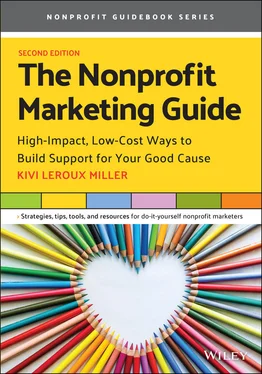Engaging supporters in conversations is more time-consuming than blasting messages out to them. Managing profiles on multiple social media sites is more time-consuming than updating your website once a month. Writing a blog with several posts per week is more time-consuming than sending out a print newsletter twice a year. Although all of these tasks do take more time, they are also more effective at building a community of supporters and encouraging them to act on your behalf.
REALITY 9: YOU'VE ALREADY LOST CONTROL OF YOUR MESSAGE – STOP PRETENDING OTHERWISE
One of the most frequent concerns we used to hear from nonprofits about using social media and participating in conversations with people online was that they would lose control of their messages. They feared people would say bad things or manipulate their image in some way.
It's questionable whether that kind of control really ever existed, but the reality is that it is long gone. If someone wants to bad-mouth you online, they can do it right now whether you are there to see it and respond or not. Shutting down your computer or phone won't prevent those conversations from happening. They'll just happen without you there to correct any misconceptions.
Rather than trying to avoid awkward, negative, or challenging conversations online, your better approach is to learn ways to effectively engage in and, where possible, manage the way those conversations play out over time. Try to bring consistency to your messaging. It's much easier to steer a conversation and to suggest topics for additional discussion than it is to control what people say.
REALITY 10: MARKETING IS NOT FUNDRAISING, BUT IT IS ESSENTIAL TO IT
Good nonprofit marketing has many possible outcomes, and raising dollars is one of them. But nonprofits also use marketing to find and galvanize volunteers; to persuade decision makers; to change public policy; to raise awareness; to encourage behavior changes; to converse with clients, supporters, and partners; to foment social change – and more.
Although you can have successful long-term marketing campaigns that don't involve fundraising, you cannot have successful long-term fundraising campaigns without marketing. Marketing and communications are how you talk to your donors in between those times when you ask for money. They're what pull new people into your pool of potential new donors and what keep current donors happy with your organization so they will give again.
This is not a fundraising guide, but you'll find fundraising-related tips and examples throughout the book, because that is one result of successful nonprofit marketing.
CONCLUSION: TRY BOLDLY, AND TRY AGAIN
There is no one best way to market your nonprofit or your good cause, although some approaches have better odds of working than others, especially given these ten realities. I've tried to include in this book both the strategies and tactics that I believe will have the greatest likelihood of success, especially for smaller organizations, but you won't know what works best for your group and your supporters until you try, gauge the results, and try again.
Don't fear failure in your nonprofit marketing. Fear will make your approaches too conservative, and you'll become just another one of the thousands of really good causes out there that struggle day to day because they don't get the support they deserve.
Instead, be bold. Author and pastor Basil King said, “Be bold and mighty forces will come to your aid.” You won't get it right the first time, and maybe not the second either. What's important is that you try new ways to reach out and grab hold of your supporters’ hearts and minds. When you do, they will come to your aid.
chapter TWO Defining Marketing in the Nonprofit Sector
When Jane Austin, the marketing director for AchieveMpls, which runs career and college readiness initiatives for high school students in Minneapolis and Saint Paul, started her job several years ago, the communications work was scattered across the organization. “Things were … a mess,” said Jane. “The website was broken. Our mission statement didn't match our actual work. No one could describe what we did. New program videos, social media accounts, and taglines popped up without notice. Our red logo appeared in a wide range of shades from pink to orange. Our designers and web consultants were far too expensive.”
Jane knew she had her work cut out for her. Getting communications on track and into the care of a professional team felt overwhelming. The other staff were long accustomed to managing their own communications projects and were suspicious of Jane's questions and offers of help.
She started with some baby steps. “Most importantly, I started by learning about my new colleagues and building their trust. I took the view that my colleagues were my clients, and I met with them to find out about their needs. I worked hard to be an attentive and responsive listener, sharing my vision that we were partners in our marketing work,” said Jane.
Over time, communications projects and decision making began to shift to Jane as she demonstrated that she knew what she was doing and could produce good work on schedule and below cost. Jane began creating new office systems, assembling a team to help build a new website, reaching out to media, and securing new vendors. As trust in Jane grew, she was able to create new communications guidelines and protocols to guide AchieveMpls's communications work and create more consistency across the organization.
“Now several years later, our little marketing team is seen as an integral partner in our programmatic and community outreach work,” said Jane. “We work hard to keep innovating our marketing work and also pay close attention to the importance of internal communications in building staff engagement.” As a result, Jane has seen AchieveMpls's visibility and reputation in the community grow, while finding her team playing an increasingly important leadership role in the health and vitality of her organization.
At Nonprofit Marketing Guide, we meet many communications staff who are at the beginning of Jane's journey: in the middle of a hot mess. Much of the work we do is centered on helping people like her do exactly what she did: professionalize the marketing and communications functions within her organization.
It's rarely an easy journey, and it often takes several years, as is it did for Jane.
Many nonprofit leaders, especially those who come to their organizations because of a passionate commitment to a specific cause, mistakenly believe that nonprofit marketing is about nothing more than creating newsletters and social media updates about the good work the nonprofit is doing. Those with corporate experience sometimes narrowly define nonprofit marketing as brand management, public relations, and advertising. Still others, especially those responsible for fundraising, believe that all nonprofit marketing should direct people to donate money. While their numbers have certainly dwindled since the first edition of this book, some people still believe that marketing is nothing more than self-interested selling that has no place in the nonprofit sector. (Those people are, of course, wrong.)
In fact, marketing in the nonprofit sector is much, much more than any of these incomplete assumptions. To manage it effectively, it's vital to understand the depth and breadth of the work.
In this chapter, we'll review a more complete definition of marketing and how it applies to the nonprofit world. We'll also look at the difference between marketing and communications . Then we'll get even more specific by reviewing and defining the most common nonprofit marketing goals, strategies, objectives, and tactics.
Читать дальше












